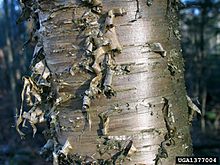Yellow birch
| Yellow birch | |
|---|---|
 |
|
| Yellow Birch foliage | |
 |
|
| Bark | |
| Scientific classification | |
| Kingdom: | Plantae |
| (unranked): | Angiosperms |
| (unranked): | Eudicots |
| (unranked): | Rosids |
| Order: | Fagales |
| Family: | Betulaceae |
| Genus: | Betula |
| Subgenus: | Betulenta |
| Species: | B. alleghaniensis |
| Binomial name | |
|
Betula alleghaniensis Britt. |
|
 |
|
| Natural range of Betula alleghaniensis | |
| Synonyms | |
|
|
Betula alleghaniensis (yellow birch, also known as golden birch), is a large and important lumber species of birch native to North-eastern North America. The name "yellow birch" reflects the color of the tree's bark. The name Betula lutea was used expansively for this tree but has now been replaced.
Betula alleghaniensis is the provincial tree of Quebec, where it is commonly called merisier, a name which in France is used for the wild cherry.
It is a medium-sized, typically single stemmed, deciduous tree reaching 60–80 feet (18–24 m) tall (exceptionally to 100 ft (30 m)) with a trunk typically 2–3 ft (0.61–0.91 m) in diameter. Yellow birch is a relatively long lived birch which typically grows 150 years and may even grow up to 300 in old growth forests.
It mostly reproduces by seed. Mature trees typically start producing seeds at about 40 years but may start as young as 20. The optimum age for seed production is about 70 years. Good seed crops are not produced every year, and tend to be produced in intervals of 1–4 years with the years between good years having little seed production. The seeds germinate best on mossy logs, decaying wood or cracks in boulders since they cannot penetrate the leaf litter layer. Yellow birch saplings will not establish in full shade (under a closed canopy) so they typically need disturbances in a forest in order to establish and grow.
Both yellow, and sweet birch have nearly identical leaf shape and both give an odor of wintergreen when crushed. To differentiate the two species the range, buds, or bark must be examined. The ranges do overlap in Appalachia where they commonly grow together, but black birch does not grow west of Ohio or north into Canada whereas yellow birch does. Black also has black non-peeling bark compared to the lighter, bronze colored, peeling bark of yellow birch. For young trees where bark has not yet developed, yellow birch can also be identified by its has hairy buds and stems; sweet birch has hairless buds.
...
Wikipedia

